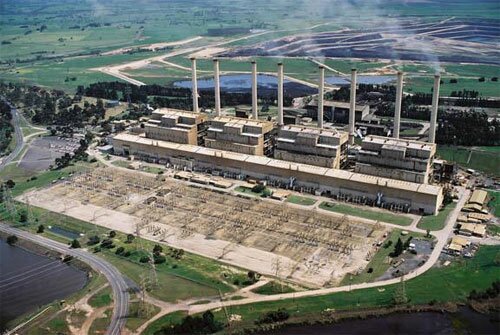High mains voltage is causing 15 millions of tonnes of un-necessary greenhouse gas pollution
Tuesday, December 2nd, 2008In Australia electricity codes stipulate that the supply voltage of mains electricity should be 230 volts (phase to neutral).
For example in Victoria the Essential Services Commission has mandated in the Electricity Supply Code that the voltage of supply should be 230 volts plus 10%, minus 6%. Distribution businesses supplying electricity err on the high side.

Lowering mains voltages could save the same amount of greenhouse gas as that produced by Hazelwood power station annually
Voltage measurements and voltage logging undertake across multiple sites by CarbonetiX show however that phase to neutral voltages are typically in the range of 240 to 250 volts. In fact we regularly see cases where the maximum voltage exceeds the maximum permissible 253 volts.
With the exception of three phase synchronous motors (eg motor typically used to power equipment such as pumps, fans, chillers, industrial machinery etc), the lower the voltage the lower the power consumption. If you remember your high school physics, you’ll know that for a resistive load Power = Volts x Current, and based on Ohms law Volts = Current x Resistance. Put the two togehter and for a resistive load (eg a halogen light bulb) power consumption is proportional to the square of voltage. So a 10% drop in voltage leads to a 19% energy saving! For single phase inductive loads such as fluorescent lighting there is also a power saving when the voltage drops.
The supply of voltage at well over the 230 volt standard means that electricity consumption, and thus greenhouse gas emissions in most buildings across Australia is higher than it would be were the voltage to be kept closer to the 230 volt standard.
I estimate that across the country a 5% electricity and greenhouse gas saving could be achieved if voltages were generally kept in the 225 to 235 volt range rather than the 240 to 250 volt range we typically see. This would translate into a greenhouse gas saving in the order of 15 million tonnes. To put this in context, that’s equivalent to the annual greenhouse gas emissions of Australia’s most climate unfriendly power station - Hazelwood - pictured above.
Distribution businesses may be supplying voltage on the high side to enable them to cope with periods of high demand, when the voltage drops in the distribution network are higher (eg on a hot summer afternoon). However these periods of high demand typically only account for around 50 to 100 of the 8760 hours in a year.
Some organisations are now installing their own voltage reduction devices to compensate for the overly high mains voltage supplied and to thus achieve cost and greenhouse gas savings.
Whilst perhaps politically challenging, there would be much greater benefit to the environment and to consumers if standards were established that kept supply voltages lower and closer to the 230 volt standard.
For example the standard could be ammended to stipulate:
- For 90% of the year the voltage shall be kept at 230 volts plus 4% minus 6%.
- For 10% of the year the voltage shall be allowed to vary between 230 volts plus 10% minus 6%.
Regulation such as this would allow distribution businesses sufficient buffer to take precautionary measures when they think demand may spike (eg based on the weather forecast) whilst still saving significant amounts of greenhouse gas.
I would encourage any organisation keen to see Australia reduce its greenhouse gas emissions take up this important issue of voltage standards with the relevant government organisations. And lets hope that as emissions trading comes in this is recognised as an opportunity for electricity generators and distribution businesses to collaborate together for significant greenhouse gas savings.


